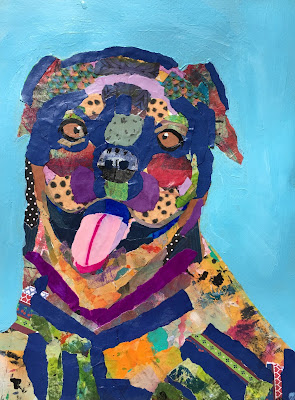Paper. Possibly my favorite material.
We do a lot of painting and drawing in the Art Room, but I always like to mix it up once in a while with some collage projects. I feel that paper projects can take us out of our comfort zone and lead us into new and exciting territory. It's more tactile, almost sculptural, and can teach a thing or two about layering, balance, harmony and texture.
I've been eyeing the paper collage artwork of artists on Pinterest for ages, (Laura Yager and Karla Schuster, to name a few) and wanting to do a similar project with my adults. After finally getting around to doing my own teacher sample, and assessing a bit the difficulties and challenges of this project, I felt it was time to introduce it to my adult class. This project was completely new and different for my students and pushed them way beyond their comfort zone, but as usual, when pushed to the limit, my adults delivered beautiful work they were super proud of.
 |
| Teacher Sample. "Freja" |
Gridding and drawing transfer:
To begin, students each brought in a black and white A4 size (printer paper size) portrait photo of their pet. We had cats, dogs, horses and pigs in the mix! Students gridded their portrait photo, and then gridded a large A3 size (roughly 42x30 cm) acrylic paper. They carefully transferred their photo grid by grid with pencil for an accurate drawing of their pet.
 |
| Gridded "Freja" photo |
 |
| "Freja" drawn using grid method |
Value analysis:
Next, students were told to analyze the different values, and value relationships in their black and white photo. This project is ALL about recognizing the subtle changes in value, their differences and similarities and the relationship of values. Understanding this will allow us to collage papers mimicking these same relationships. For example, the nose might be the darkest value on the animal, and this same value might also be under the ear, or under the collar. To stay true to the value relationships, we might use the same dark collage paper (or one of similar value) to represent these areas on our animal. Similarly, a very light value at the top of the head, on the cheek and on the shoulder might be represented with the same or a similar valued collage paper. Maintaining the value relationships we see in the black and white photo is key to giving our animal its accurate dimension and structure. Tough concept, but my students all got it.
 |
| Underpainting |
As always, I like to begin with an undercoat, or underpainting. This allows hints of color to peek through the collage paper bits, and just adds more depth to our painting. I painted the whole paper in ochre, then went over the negative space area around my dog in a dark green.
Collaging:
The key to this project is in the diversity of papers available. We used old book paper in various stages of yellowing, atlas paper and maps, dictionaries, gridded and graph paper, sheet music, painted paper (we used old painting place mats), stamped and printed paper, plain colored paper, patterned decoupage paper, neutral paper, colorful paper, bright and dark paper. Students chose papers according to their preference but with attention to their value relationships. Some chose to limit their paper types, for better balance and harmony.
Then the tearing began! You could start dark to light, light to dark, or section by section. It all works.
We tore bit by bit, and pasted as we went using acrylic gel medium and a flat brush. Pieces were pasted side by side and overlapping. Students were asked to consider symmetry (since working with faces, symmetry is important), so if using a patterned blue paper over the left eye, we might use this same paper over the right eye (also good for balance and harmony).
 |
| Work in progress |
Once all values were created using paper, we worked on our small features and details. These were in large part also done with paper, but we also used a fine detail brush to help us get the accurate fine details right in the eyes, mouth and whiskers.
Background:
Finally, we assessed the colors and textures in our piece and decided which color background we wanted. We already has a preliminary undercoat, and some chose to allow this undercoat to slightly shine through the second coat of background color (good for texture and interest). Others chose a more flat, even and opaque application of a new color.
Wow, these were super intense but such a joy. My students loved the ritualistic act of tearing, tearing, tearing. It was truly meditative, yet we still had to remain finely tuned to the smallest details.
A perfect balance, I think!
And the best part? These have personal significance to my students, since each animal is or was at some point in their lives, their beloved pet (minus the piglet)!






